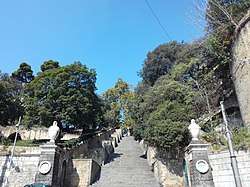Stairways in Naples

Pedamentina stairs.

Pedamentina stairs.

Sant'Antonio ai Monti stairs.

Petraio stairs.

San Marcellino stairs.

Capodimonte stairs.
The stairways of Naples are over 200[1] and are complex urban systems that connect various areas of the city. The history of these ramps is mainly due to expansions outside the walls of the sixteenth century.
History
The stairways of Naples are ancient pedestrian paths that connect the hills with the center and the coast. The oldest graded paths of the city, most of the time, were born thanks to the coverage of streams or springs, which once flowed just outside the city.
These paths were also made to easily connect the various monumental, especially religious, emergencies: monasteries, retreats, churches, etc. or above all, for urban planning needs.
They are still the subject of study and are considered real urban masterpieces.[2]
Main stairs
- Pedamentina stairs
- Petraio stairs
- Capodimonte stairs
- Santa Maria Apparente stairs
- Moiariello stairs
- Giuseppe Piazzi stairs
- Cacciottoli stairs
- San Francesco stairs
- Montesanto stairs
- Bernando Celentano stairs
- Cosma e Damiano stairs
- Paradiso stairs
- Santa Barbara stairs
- Cupa vecchia stairs
References
- ↑ Donatella Bernabò Silorata (14 January 2014). "Napoli segreta, le scale delle meraviglie" [Secret Naples, the stairs of wonders]. L'Espresso (in Italian).
- ↑ Gabriella Guida, Napoli in salita e in discesa, Intra Moenia, 2000, ISBN 88-7421-056-6.
This article is issued from
Wikipedia.
The text is licensed under Creative Commons - Attribution - Sharealike.
Additional terms may apply for the media files.